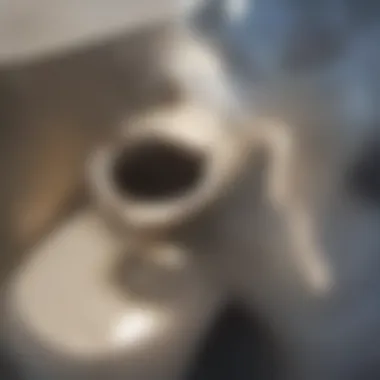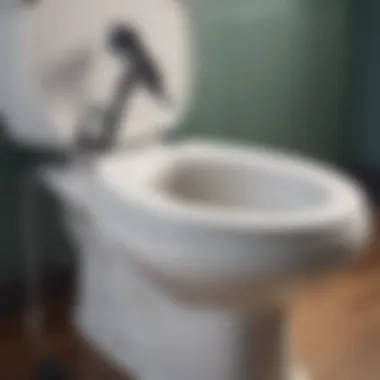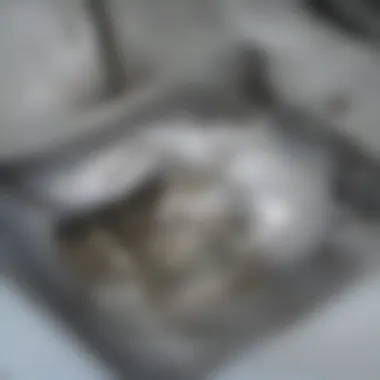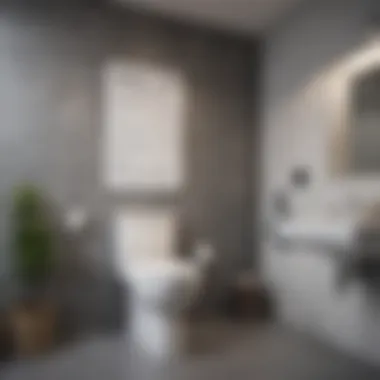Effective Strategies for Clearing Toilet Clogs


Intro
Clogged toilets are a common nuisance that many homeowners encounter. Addressing this problem efficiently is vital to maintaining a functional bathroom. In this article, we will explore practical methods for clearing toilet clogs, from tools to techniques. Our focus is on providing you with a comprehensive guide that will not only help you resolve current issues but also equip you with preventative strategies for the future.
The subsequent sections will cover traditional methods, innovative tools, and necessary maintenance practices to keep your toilet functioning smoothly. Knowledge of these effective strategies can make the difference between a minor inconvenience and a significant disruption in your home.
Let's dive into the essential components of clearing toilet clogs.
Understanding Toilet Clogs
Understanding toilet clogs is essential for homeowners and anyone interested in maintaining their home environment effectively. Knowledge about what causes clogs and how to identify them can help prevent inconvenience and save time and costs associated with plumbing issues. Understanding this topic is a proactive approach. By recognizing potential problems early, one can mitigate damage and restore a functional bathroom.
Common Causes of Clogs
Toilet clogs often arise from several common causes. Recognizing these can assist in preventing future issues. Some main factors include:
- Excessive Toilet Paper Usage: Using too much toilet paper can quickly lead to blockages. Limit amount used to what is necessary.
- Non-Flushable Items: Items such as wipes, feminine hygiene products, and even dental floss should never be flushed. They often do not break down and cause significant blockages.
- Foreign Objects: Kids may accidentally drop toys or other objects into the toilet. Such incidents can create difficult clogs that regular cleaning cannot resolve.
- Tree Roots: In some cases, tree roots can invade sewer lines, leading to slow drains and eventual blockages. Although this goes beyond the toilet itself, it requires attention.
These common causes highlight the importance of proper toilet use and awareness.
Signs of a Clogged Toilet
Identifying the signs of a clogged toilet early can prevent more severe problems. Here are key indicators:
- Slow Flushing: If water takes longer to drain than usual, it may indicate a developing clog.
- Unpleasant Odors: Foul smells can signal waste buildup in the pipes, pointing to a clog.
- Gurgling Sounds: Strange noises when flushing can be a warning that air is trapped in the plumbing due to a blockage.
- Water Backflow: If water rises in the bowl after flushing or does not go down, it is a clear sign of blockage.
Essential Tools for Unclogging
Effective unclogging of toilets hinges on the proper tools. These tools not only simplify the process but also enhance the chances of a successful outcome. Having the right equipment can save time, reduce frustration, and prevent potential damage to plumbing systems. Understanding the various tools available and their specific functions is essential for anyone looking to manage toilet clogs with confidence.
The Plunger
Types of plungers
Plungers exist in various types, each designed for specific clogs. The most common types are the cup plunger and the flange plunger. The cup plunger features a simple rubber cup connected to a wooden or plastic handle. It is typically used for sinks and bathtubs. In contrast, the flange plunger has a distinctive flange protruding from the cup, which makes it suitable for toilets. Its design allows for a better seal within the toilet bowl, enhancing suction power. For claening toilet clogs, the flange plunger is generally considered the more effective option due to its specialized design.
How to use a plunger effectively
Utilizing a plunger effectively involves specific techniques. First, ensure that the toilet bowl contains enough water to cover the plunger cup, as this helps create suction. Align the flange of the plunger over the drain hole and push down gently to create a seal. Then, thrust the plunger up and down with force but without breaking the seal. Repetition of this motion is key, typically five to ten times, check for drainage. This method's success largely depends on the ability to create a strong vacuum, utilizing the forces of pressure and suction to dislodge the clog.


Plumbing Snake
Choosing the right snake
Selecting the appropriate plumbing snake plays a crucial role in unclogging toilets. A basic hand-cranked snake is often sufficient for minor blockages, while motorized options may be necessary for more severe clogs. The length and flexibility of the snake are significant considerations, as a longer, flexible snake can navigate through the twists of plumbing without damaging pipes. Knowing which snake fits your particular needs is vital for effective use.
Utilizing a plumbing snake
Using a plumbing snake involves insertion into the toilet drain to break up or retrieve the clog. Start by inserting the snake into the drain, turning the handle clockwise to allow the snake to grip the obstruction. Once you feel resistance, rotate the snake to break up the clog. It is essential to handle the snake gently to avoid damaging pipes. The versatility of this tool allows it to tackle a wide range of clogs, accommodating different obstacles.
Wet/Dry Vacuum
Setup and usage
Setting up a wet/dry vacuum is straightforward but requires careful attention to safety. First, ensure the vacuum is set to the wet setting if you are dealing with liquids. Insert the hose into the toilet bowl, making sure to create a tight seal around the drain opening. Activate the vacuum, allowing it to draw out the clog and water mixture. This method is particularly effective for retrieving small objects that may have caused the blockage. The wet/dry vacuum provides an efficient solution, especially for those equipped with this versatile tool at home.
Limitations of this method
Despite its advantages, the wet/dry vacuum has limitations. It may not effectively handle large, stubborn clogs often present in toilets. Additionally, it requires a degree of technical knowledge to operate safely and effectively. If the clog is beyond the reach of the vacuum hose, this solution can become ineffective. Therefore, while it serves as a strong option for smaller issues, it should not be the sole method relied upon for all types of clogs.
Chemical Drain Cleaners
Types of chemical cleaners
Chemical drain cleaners come in various formulations, including caustic, oxidizing, and enzymatic types. Caustic drain cleaners work by producing heat and breaking down organic matter, making them effective for grease and hair clogs. Oxidizing cleaners offer similar effects but are generally safer on pipes. Enzymatic cleaners, on the other hand, use bacteria to consume organic material. Each has its unique applications and effectiveness depending on the nature of the clog.
Safety precautions
Ensuring safety when using chemical drain cleaners cannot be overstated. Always wear gloves and eye protection to prevent harm due to splashes. Using chemicals indoors necessitates ventilation to reduce inhalation risks. Also, follow the instructions closely, as improper use can damage plumbing and pose health risks. A cautious approach will maximize safety while utilizing chemical cleaners for unclogging tasks.
Step-by-Step Clog Clearing Techniques
Addressing a clogged toilet can be frustrating, but with the right techniques, the process becomes manageable. This section outlines effective methods for clearing clogs, emphasizing the importance of understanding your tools and procedures. Utilizing a systematic approach ensures maximum efficiency and minimizes the risk of damage to your plumbing. A well-informed homeowner can tackle most minor toilet issues without needing professional assistance.
Using a Plunger
A plunger is often the first tool that comes to mind when dealing with a clogged toilet. This simplicity of use makes it a staple in household maintenance. To use a plunger effectively, ensure that you have a flange plunger. This type has an extended rubber rim that creates a better seal in the toilet bowl compared to a standard cup plunger.
- Position the Plunger: Place the plunger in the bowl, submerging the rubber part completely in water. This helps create suction.
- Create a Firm Seal: Push down slowly to create a firm seal around the drain hole. A proper seal is critical for effective suction and pressure.
- Use Pumping Action: Push and pull vigorously, maintaining the seal with quick thrusts, for around 15-20 seconds. The goal is to push air and water through the clog.
- Check Progress: After several thrusts, if the water begins to drain, you may have dislodged the clog. Flush the toilet to verify.


Remember to use a plunger only for toilet clogs, as other drains require different approaches.
Employing a Plumbing Snake
When a plunger does not clear the blockage, a plumbing snake might be the answer. This flexible tool allows you to reach deeper clogs that are beyond the reach of a plunger. To effectively use a plumbing snake:
- Insert the Snake: Gently push the snake into the toilet bowl until you encounter resistance, indicating the location of the clog.
- Rotate the Handle: Turn the handle of the snake clockwise while pushing it forward. This allows the coil of the snake to catch and break up the clog.
- Extract and Flush: After the clog seems cleared, carefully pull the snake out and flush the toilet to ensure everything is flowing smoothly.
Chemical Solutions
Chemical drain cleaners are another option for clearing stubborn clogs. However, caution is required due to the potential hazards these substances can pose. When choosing chemical solutions:
- Select the Right Product: Ensure you are using a cleaner specifically designed for toilets. Products like Liquid-Plumr or Drano are popular choices.
- Follow Instructions: Read all packaging instructions thoroughly. Different chemicals have varying recommended contact times and methods of application.
- Protect Yourself: Always wear gloves and goggles to prevent skin irritation and eye damage from splashes.
Wet/Dry Vacuum Method
The wet/dry vacuum is an unconventional yet effective tool for clearing clogs. Its powerful suction can help remove blockages that are otherwise difficult to reach. Here is a guideline on how to proceed:
- Set Up the Vacuum: Before starting, switch the vacuum to the liquid setting. Ensure it can handle the water in the toilet.
- Seal the Toilet Drain: To create a proper suction, you may need to seal around the bowl edge with a wet rag. This prevents air from escaping.
- Vacuum the Clog: Place the hose into the toilet bowl and turn on the vacuum. This should start sucking out any debris blocking the drain.
- Check for Success: Turn off the vacuum and flush the toilet to test whether the clog has been successfully removed.
Utilizing these step-by-step techniques can drastically reduce the stress involved in dealing with toilet clogs. Through the right knowledge and tools, most clogs can be addressed efficiently, leaving you with a functional bathroom once again.
Preventing Future Clogs
Preventing future clogs is an essential aspect of toilet maintenance that often gets overlooked. Many homeowners deal with the repercussions of clogs without considering the simple practices that can avert them. With proper preventive measures, one can save time, money, and frustration. This approach not only enhances the longevity of plumbing systems but also emphasizes the overall functionality of a bathroom in a household.
Proper Toilet Use Practices
Toilets are designed with specific usage in mind. Adhering to proper practices can greatly reduce the occurrence of clogs. This includes being mindful of what gets flushed down the toilet. Only human waste and toilet paper are acceptable. Items such as wipes, feminine products, and other non-biodegradable items should never be disposed of in the toilet, as they can lead to severe blockages that require professional intervention.
In addition, flushing multiple times for large items can assist in alleviating pressure in the plumbing. Regularly educating family members and guests about these practices can promote better usage habits overall. This consideration immediately contributes to a healthy plumbing system and prevents unnecessary headaches over clogged toilets.
Regular Maintenance Tips
Regular maintenance is vital for avoiding toilet clogs. Following some systematic practices helps maintain the efficiency of your toilet.
Routine inspections
Routine inspections should be a priority for homeowners. This involves checking for leaks, evaluating the flush mechanism, and monitoring for any unusual signs that could indicate a potential clog. By keeping an eye on these indicators, one can catch problems early and address them before they escalate. The key characteristic of routine inspections is their proactive nature. This serves as a beneficial approach in this article as it focuses on preventing problems instead of merely fixing them after they occur.


The unique feature of routine inspections lies in their simplicity and effectiveness. In fact, dedicating just a few minutes monthly for this task can provide peace of mind and save money on extensive repairs.
Cleaning recommendations
Cleaning recommendations encompass a structured approach to maintaining a toilet’s cleanliness. Regular cleaning not only enhances hygiene but it also prevents residue build-up that can lead to clogs. Using non-abrasive and chemical-free cleaners is advisable to maintain the integrity of the toilet components. The emphasis on cleaning is significant in this article as it ensures that toilets function optimally without unnecessary interruptions.
A unique aspect of effective cleaning rituals includes the use of a toilet brush along with a suitable cleaner. This method is popular since it removes grime efficiently without risk of damage. While choosing products, be cautious of harsh chemicals that may degrade the materials over time. Overall, adopting these cleaning recommendations ensures a cleaner and more functional toilet.
Troubleshooting Persistent Clogs
Troubleshooting persistent clogs is a critical aspect of maintaining a well-functioning toilet. When basic clearing methods fail, it is important to analyze and address the underlying issues causing the blockage. Understanding this aspect enables homeowners to distinguish between simple clogs that can be managed personally and those requiring professional intervention. Effective troubleshooting can save time and prevent further damage to plumbing systems, ultimately preserving the integrity of your home.
When to Call a Professional
Recognizing when to involve a plumbing professional can be difficult. However, certain signs indicate that a simple DIY solution may not suffice.
- Chronic Clogs: If a toilet clogs repeatedly even after attempts to clear it, this may suggest more complex issues within the plumbing.
- Multiple Fixtures Affected: If other drains in the house are slow or backing up when the toilet is used, it points to a potential main line issue.
- Noisy Pipes: Unusual sounds in plumbing during flush may signal air trapped in pipes or issues with venting.
- Standing Water: If water remains stagnant after attempting to clear it, it indicates a serious blockage.
- Attempts Fail: If efforts to use a plunger or plumbing snake do not yield results, it’s time to consult a professional.
Calling a plumber may seem like a bigger expense upfront, but it often prevents larger repair costs that arise from neglecting plumbing issues.
Assessing the Severity of the Clog
Evaluating the severity of a clog is essential for determining the appropriate course of action.
- Initial Diagnostics: Start by flushing the toilet; observe how the water behaves. If it drains slowly or overflows, a clog is evident.
- Visual Checks: Look for visible blockages. Sometimes, items can be seen in the toilet bowl that should not be there, such as toys or excessive paper.
- Suction and Pressure Tests: Using a plunger, assess how much resistance there is when creating suction. Low resistance may indicate a minor clog while considerable resistance suggests a blockage.
- Floor Drain Symptoms: Check floor drains. Backflow in these areas can be a sign of severe plumbing issues.
- Healthy Flow Patterns: If flushing causes other toilets to gurgle or drain poorly, severity is likely higher than an isolated block.
Signs like these warrant careful consideration and can help avoid confusion later. Knowing when to act decisively can prevent further issues down the line.
Closure
Toilets are essential fixtures in any home, and understanding effective methods for addressing toilet clogs is crucial. The importance of this conclusion lies in summarizing the key methods and considerations that were discussed throughout the article. Recognizing the variety of techniques and tools available not only empowers homeowners but also alleviates the frustrations associated with a clogged toilet. Proper knowledge ensures that one can tackle issues swiftly and prevents unnecessary damage to the plumbing.
Summary of Methods
The methods explored in this article cover a spectrum of practicality and approach. Here is a brief summary:
- Using a Plunger: This tool is a household staple for a reason. Understanding the types of plungers and mastering their effective use can often clear basic clogs without much hassle.
- Employing a Plumbing Snake: For those tougher obstructions, having a plumbing snake on hand is beneficial. Knowing how to choose and operate this tool can save time and effort.
- Chemical Solutions: Chemical drain cleaners can be an effective last resort, but caution and safe practices are essential due to their hazardous nature.
- Wet/Dry Vacuum Method: This method has its limitations but can provide instant relief when executed properly. Understanding setup and usage can avoid further complications.
Each method has its context and suited application, which should be taken into account when addressing clogs.
Final Thoughts on Toilet Maintenance
Routine toilet maintenance and the adoption of proactive measures are key to minimizing the frequency of clogs. Proper usage practices, such as avoiding flushing non-biodegradable items, cannot be overstated.
In addition, regular inspections and cleaning can help sustain the overall health of plumbing systems. Incorporating these practices into home care ensures longevity and functionality in the bathroom.
By blending these techniques with an understanding of the home plumbing environment, homeowners can take substantial steps toward efficient toilet maintenance. The aim is not just to fix immediate problems but to foster a long-term, functional relationship with one of the most important aspects of household management.



